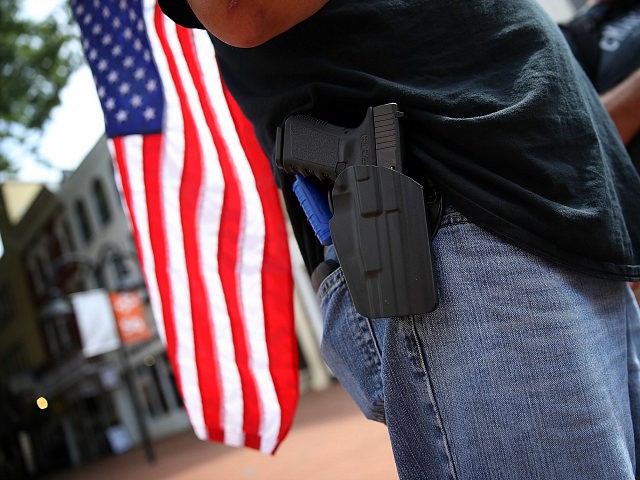Get ready. This Wednesday, the Supreme Court will hear oral arguments in a major Second Amendment case, New York State Rifle & Pistol Association v. Bruen.
In my previous article, I showed why the State of New York uses an abstract concern for “public safety” to justify restricting the right to carry guns outside the home. But over the past two decades the massive expansion of licensed (and unlicensed) carriers has corresponded with a significant drop in violent crime. I also discussed how Americans have used firearms for defensive purposes in millions of cases.
So, how can we expect New York to make its public safety case?
Easy—by cherry-picking studies. Expect New York’s lawyers to cite some research purporting to show that restrictive gun laws actually lead to a decrease in crime.
But don’t be fooled. A single study in isolation isn’t worth much. You must check the quality and reliability of each evaluation. And you must survey the broader literature to get a comprehensive view of the empirical data.
Fortunately, organizations like the National Research Council, the Centers for Disease Control (CDC), and the RAND Corporation have done such comprehensive surveys. These are all establishment organizations. You wouldn’t expect them to be eager to promote gun rights. And yet their findings damage the anti-gun case.
The National Research Council is the research arm of the National Academies of Sciences, Engineering, and Medicine. Its study was published in 2005, and it can be found here. The study concluded, “With the current evidence it is not possible to determine that there is a causal link between the passage of right-to-carry-laws and crime rates.” There was one dissent on this issue. Committee member James Q. Wilson, the esteemed political scientist, concluded that the available evidence “suggests that [right-to-carry] laws do in fact help drive down the murder rate…” No one suggested that the evidence showed right-to-carry laws increase murder or other violent crimes.
The CDC study also was published in 2005, and it can be found here. Like the National Research Council, the CDC said that the available studies didn’t offer enough evidence to support anti-gunner claims about right-to-carry laws, also known as “shall-issue” laws. The CDC concluded that “further research is needed to assess the effects of shall issue laws on violence.”
The RAND Corporation supplied further research in a study published in 2020. This study also is available online. RAND investigated whether shall-issue laws lead to a host of ills: suicides, homicides, firearm homicides, robberies, assaults, unintentional firearm injuries and deaths, and mass shootings. And like the National Research Council and the CDC, RAND couldn’t find conclusive evidence to support anti-gun arguments.
The only category for which RAND found even limited evidence was a relationship between shall-issue laws and increased violent crime. But even that was a stretch. As RAND admitted, the evidence was inconclusive about the effect of shall-issue laws on “each component of violent crime.” So, it’s hard to see how shall-issue laws could increase violent crime overall.
What’s more, most of the studies RAND reviewed didn’t support a relationship between shall-issue laws and increased violent crime. Only two of them did, and those two are hardly compelling.
The first appeared in 2016. A team of scholars led by the University of Chicago’s Steven Durlauf wrote the study. Durlauf and his team acknowledged that the evidence relating shall-issue laws to violent crime was “weak.” They concluded that the “literature on shall-issue carry laws” is not “a body of work from which conclusions may be drawn.”
So, not exactly a crushing blow for the anti-gun side.
The second study was published in 2019. Stanford law professor John Donohue was the lead author. The anti-gunners often rely upon this study. For example, New York’s brief in the Bruen case cites Donohue’s research.
Too bad the study appears to have little probative value.
Georgetown University professor William English has published a persuasive critique of the Donohue study. English argues that it relies on a flawed analysis. For starters, Donohue used improper data-weighting techniques. As English reveals, once you correct for that improper weighting, Donohue’s violent-crime findings disappear.
More fundamentally, Donohue measured the wrong thing. He simplistically compared crime rates before and after the passage of shall-issue laws. The problem? He didn’t account for the number of permits actually issued. This makes no sense! The mere passage of a shall-issue law couldn’t lead to an increase in crime. What matters is whether and how citizens obtained permits and carried firearms. When English accounted for actual permit issuance, he found no statistically significant correlation between permit rates and violent crime.
Donohue also used a model of analysis called “synthetic controls.” He didn’t compare shall-issue states to other real states. Instead, he compared them to “synthetic” (i.e., non-existent, invented) states. His “synthetic states” were Frankenstein-type monsters made up of parts of actual states. And again, the Donohue study is probably the best one the anti-gun crowd can find for their public safety argument yet it seems that its conclusions are unpersuasive.
To close, New York wants the Supreme Court to think that there will be blood running in the streets, if we don’t restrict the right to carry. But the empirical data doesn’t support this claim. Just ask the 44 states that allow all law-abiding citizens to carry. (For more on this topic, see the amicus briefs filed in Bruen by Professor William English and by law enforcement groups.)
* Attorney Mark W. Smith is a Presidential Scholar and Senior Fellow in Law and Public Policy at The King’s College, a New York Times bestselling author, and the host and producer of The Four Boxes Diner on YouTube, a channel providing in-depth analysis on Second Amendment scholarship, legal matters, news, and issues.

COMMENTS
Please let us know if you're having issues with commenting.